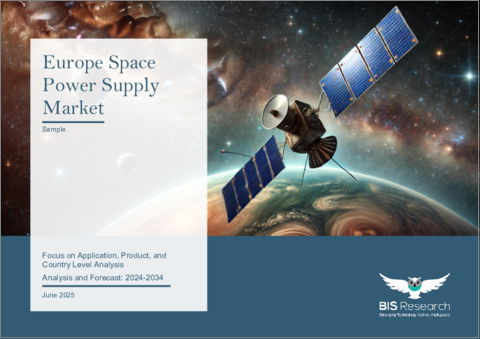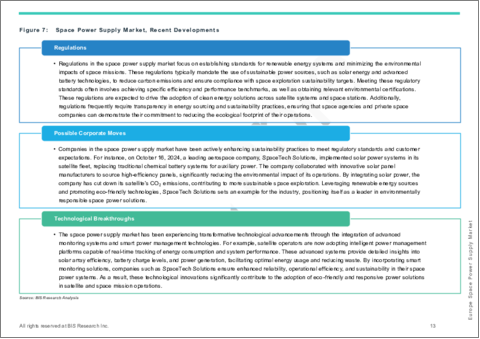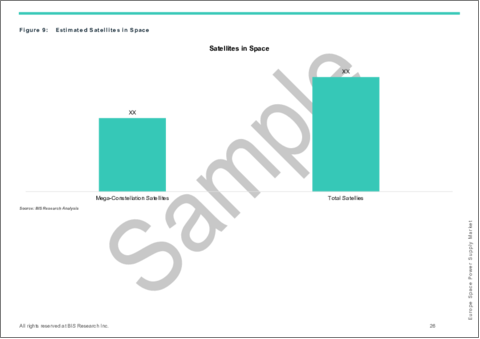|
|
市場調査レポート
商品コード
1748470
欧州の宇宙用電源市場:用途・製品・国別の分析・予測 (2024-2034年)Europe Space Power Supply Market: Focus on Application, Product, and Country Level Analysis - Analysis and Forecast, 2024-2034 |
||||||
カスタマイズ可能
|
|||||||
| 欧州の宇宙用電源市場:用途・製品・国別の分析・予測 (2024-2034年) |
|
出版日: 2025年06月16日
発行: BIS Research
ページ情報: 英文 91 Pages
納期: 1~5営業日
|
全表示
- 概要
- 図表
- 目次
欧州の宇宙用電源の市場規模は、2024年の6億3,958万2,300米ドルから、予測期間中は4.09%の成長率で推移し、2034年には9億5,466万1,100米ドルに達すると予測されています。
同市場には、太陽光発電システム、改良型バッテリー、エネルギー貯蔵ソリューション、電源管理ユニットなど、衛星、宇宙船、軌道プラットフォームの運用に必要な幅広い技術が含まれます。この産業は、信頼性が高く、効率的で、自律的な電源に対する要求の高まりに後押しされ、欧州の宇宙開発への意欲の高まりに応えるべく急速に開発されています。商業・科学分野の宇宙活動の電力供給において、欧州の宇宙ミッションは、堅牢な電力設計、軽量のエネルギー貯蔵技術、高効率の太陽電池アレイへの依存をますます強めています。任務ごとの要件や持続可能性の目標を達成するため、Thales Alenia SpaceやAirbus Defence and Spaceといった地域の大手企業に加え、新興のスタートアップ企業も、次世代電源技術への大規模な投資を行っています。さらに同市場は、EU支援のプロジェクトやESA (欧州宇宙機関) 主導のプログラムの影響も受けており、特にエネルギー最適化、ミッションの長寿命化、技術主権に重点を置いたイノベーションと競争力の強化が促進されています。欧州の宇宙用電源市場は、深宇宙探査、通信、地球観測といった需要の高まりに対応するかたちで、衛星サービスや宇宙探査における戦略目標を支えるための、高度かつスケーラブルなソリューションを提供し続けています。
| 主要市場統計 | |
|---|---|
| 予測期間 | 2024-2034年 |
| 2024年の評価額 | 6億3,958万2,300米ドル |
| 2034年予測 | 9億5,466万1,100米ドル |
| CAGR | 4.09% |
欧州の宇宙用電源市場は、同地域が軌道サービス、衛星打ち上げ、宇宙探査においてその存在感を拡大する上で極めて重要な要素となっています。衛星、深宇宙探査機、有人ミッション、宇宙インフラはすべて、太陽電池アレイ、バッテリー、燃料電池、電力管理エレクトロニクスといった電源システムに依存しています。民間の宇宙企業や欧州宇宙機関 (ESA) などの政府系機関による取り組みにより、欧州の宇宙産業が急成長を遂げる中で、信頼性が高く、効果的で、長期間の使用に耐える電源ソリューションの必要性が高まっています。
欧州企業は、次世代衛星、キューブサット、深宇宙ミッションのニーズを満たすため、軽量、耐放射線性、高効率のシステムを開発しています。エネルギー貯蔵と電力調整技術の革新は、Horizon EuropeやESAのARTES (Advanced Research in Telecommunications Systems) などのプログラムによって資金提供されています。持続可能性とミッションの自律性が重要視される中、太陽電気推進やその他のクリーンエネルギーシステムに対する大きな後押しがあります。
欧州は、宇宙の自律性を達成し、外国技術への依存度を下げ、衛星ベースサービスのリーダー的地位を維持するという戦略的目標を掲げており、市場の形成はさらに進んでいます。技術革新、協力、新興国市場の需要開拓に支えられ、欧州の宇宙電源市場は、高い開発コストや複雑な規制などの障害にもかかわらず、大幅な拡大が見込まれています。
市場セグメンテーション
セグメンテーション1:用途別
- 衛星
- 宇宙探査・深宇宙ミッション
- 着陸機
- 探査車
- 軌道機
- 宇宙ステーション・居住モジュール
- 打ち上げ機
- 小型・中型ロケット
- 大型・超大型ロケット
セグメンテーション2:衛星軌道別
- 低軌道 (LEO) 衛星
- 静止軌道 (GEO) 衛星
- 中軌道 (MEO) 衛星
- 地球外軌道衛星
セグメンテーション3:衛星タイプ別
- 小型衛星 (キューブサット、ナノサット) (1~10 kW)
- 中型衛星 (10~15kW)
- 大型衛星 (15kW以上)
セグメンテーション4:コンポーネントタイプ別
- 太陽光発電システム
- 太陽電池
- ソーラーアレイ?パネル
- バッテリーシステム
- 電力管理・配電 (PMAD) システム
セグメンテーション5:国別
- ドイツ
- フランス
- 英国
- ロシア
- その他
欧州の宇宙用電源市場:市場動向・促進要因・課題:
動向
- 小型衛星やキューブサットの配備拡大により、小型電源システムの需要が増加
- 太陽電池アレイの効率と軽量電池技術の進歩
- 高性能の電力管理を必要とする電気推進システムの使用の増加
- 電力システムの監視と最適化のためのAIとデジタルツインの統合の増加
- 欧州における民間宇宙ミッションと民間宇宙企業の拡大
- 多目的衛星プラットフォームに向けたモジュール式でスケーラブルな電源システムへの注目の拡大
促進要因
- 深宇宙や地球観測ミッションに対するESAや各国の宇宙プログラムからの強力な支援
- 通信、航行、リモートセンシング(遠隔探査)などの衛星ベースサービスに対する需要の増加
- Horizon Europeやその他の資金援助プログラムを通じた、EUによる宇宙イノベーションへの投資
- 宇宙の自律性と非EUサプライヤーへの依存度低減に向けた戦略的重点化
- エネルギー貯蔵、電力調整、熱管理における技術進歩
課題
- 出力、質量、熱的制約の間の工学的トレードオフが必要
- 過酷な宇宙環境のため、耐放射線性と長期耐久性を備えた部品が必要
- 欧州内の宇宙仕様の材料と電子機器のサプライチェーンが限られています。
- 高い開発コストと長い認証スケジュール
- 多様なミッション・プロファイルや軌道環境に電力システムを適応させる際の複雑さ
主要企業
- AZUR SPACE Solar Power GmbH
- CESI S.p.A.
- S.A.B. Aerospace Srl
- AIRBUS
- Saft
当レポートでは、欧州の宇宙用電源の市場を調査し、主要動向、市場影響因子の分析、法規制環境、技術・特許の分析、市場規模の推移・予測、各種区分・主要国別の詳細分析、競合情勢、主要企業のプロファイルなどをまとめています。
目次
エグゼクティブサマリー
範囲と定義
第1章 市場:業界展望
- 動向:現状と将来への影響評価
- 宇宙用途向け多接合太陽電池の進歩
- 衛星搭載用薄膜・フレキシブル太陽電池の開発
- 太陽光パネルの効率向上と電力密度の向上
- 長期ミッション向け宇宙太陽光発電 (SBSP) システムの革新
- サプライチェーンの概要
- バリューチェーン分析
- 特許分析
- 特許出願動向 (国別)
- 特許出願動向 (企業別)
- 規制状況と業界の取り組み
- 規制と政策
- 市場力学の概要
- 市場促進要因
- 市場抑制要因
- 市場機会
- メガコンステレーションの太陽光発電需要への影響と従来の衛星配備との比較
第2章 地域
- 地域サマリー
- 欧州
- 市場
- 用途
- 製品
- 欧州 (国別)
第3章 市場-競合ベンチマーキングと企業プロファイル
- 次のフロンティア
- 地理的評価
- 主要な宇宙用電源プログラム
- 宇宙用電源プログラムにおける主要技術の選好傾向
- 宇宙用電源市場における主要契約企業の動向
- 企業プロファイル
- 宇宙向け太陽光発電ソリューション
- 宇宙向けバッテリー電源ソリューション
- その他の主要企業
第4章 調査手法
List of Figures
- Figure 1: Europe Space Power Supply Market Scenarios, 2024, 2029, 2034
- Figure 2: Space Power Supply Market (by Region), $Thousand, 2024, 2029, and 2034
- Figure 3: Europe Space Power Supply Market (by Application), $Thousand, 2024, 2029, and 2034
- Figure 4: Europe Space Power Supply Market (by Orbit), $Thousand, 2024, 2029, and 2034
- Figure 5: Europe Space Power Supply Market (by Satellite Type), $Thousand, 2024, 2029, and 2034
- Figure 6: Europe Space Power Supply Market (by Component Type), $Thousand, 2024, 2029, and 2034
- Figure 7: Space Power Supply Market, Recent Developments
- Figure 8: Supply Chain of Space Power Supply Market
- Figure 9: Space Power Supply Market (by Country), January 2022-December 2024
- Figure 10: Space Power Supply Market (by Company), January 2022-December 2024
- Figure 11: Estimated Satellites in Space
- Figure 12: Germany Space Power Supply Market, $Thousand, 2023-2034
- Figure 13: France Space Power Supply Market, $Thousand, 2024-2034
- Figure 14: U.K. Space Power Supply Market, $Thousand, 2024-2034
- Figure 15: Russia Space Power Supply Market, $Thousand, 2024-2034
- Figure 16: Rest-of-Europe Space Power Supply Market, $Thousand, 2024-2034
- Figure 17: Strategic Initiatives, 2022-2025
- Figure 18: Share of Strategic Initiatives, 2022-2025
- Figure 19: Data Triangulation
- Figure 20: Top-Down and Bottom-Up Approach
- Figure 21: Assumptions and Limitations
List of Tables
- Table 1: Market Snapshot
- Table 2: Opportunities across Regions
- Table 3: Trends: Overview
- Table 4: Impact Analysis of Market Navigating Factors, 2024-2034
- Table 6: Europe Space Power Supply Market (by Application), $Thousand, 2023-2034
- Table 7: Europe Space Power Supply Market for Satellite (by Orbit), $Thousand, 2023-2034
- Table 8: Europe Space Power Supply Market for Satellite (by Satellite Type), $Thousand, 2023-2034
- Table 9: Europe Space Power Supply Market (by Component Type), $Thousand, 2023-2034
- Table 10: Germany Space Power Supply Market (by Application), $Thousand, 2023-2034
- Table 11: Germany Space Power Supply Market for Satellites (by Orbit), $Thousand, 2023-2034
- Table 12: Germany Space Power Supply Market for Satellites (by Satellite Type), $Thousand, 2023-2034
- Table 13: Germany Space Power Supply Market (by Component Type), $Thousand, 2023-2034
- Table 14: France Space Power Supply Market (by Application), $Thousand, 2023-2034
- Table 15: France Space Power Supply Market for Satellites (by Orbit), $Thousand, 2023-2034
- Table 16: France Space Power Supply Market for Satellites (by Satellite Type), $Thousand, 2023-2034
- Table 17: France Space Power Supply Market (by Component Type), $Thousand, 2023-2034
- Table 18: U.K. Space Power Supply Market (by Application), $Thousand, 2023-2034
- Table 19: U.K. Space Power Supply Market for Satellites (by Orbit), $Thousand, 2023-2034
- Table 20: U.K. Space Power Supply Market for Satellites (by Satellite Type), $Thousand, 2023-2034
- Table 21: U.K. Space Power Supply Market (by Component Type), $Thousand, 2023-2034
- Table 22: Russia Space Power Supply Market (by Application), $Thousand, 2023-2034
- Table 23: Russia Space Power Supply Market for Satellites (by Orbit), $Thousand, 2023-2034
- Table 24: Russia Space Power Supply Market for Satellites (by Satellite Type), $Thousand, 2023-2034
- Table 25: Russia Space Power Supply Market (by Component Type), $Thousand, 2023-2034
- Table 26: Rest-of-Europe Space Power Supply Market (by Application), $Thousand, 2023-2034
- Table 27: Rest-of-Europe Space Power Supply Market for Satellites (by Orbit), $Thousand, 2023-2034
- Table 28: Rest-of-Europe Space Power Supply Market for Satellites (by Satellite Type), $Thousand, 2023-2034
- Table 29: Rest-of-Europe Space Power Supply Market (by Component Type), $Thousand, 2023-2034
- Table 30: Market Share, 2023
- Table 31: Key Space Power Supply Programs
- Table 32: Key Technologies for Space Power Supply Programs (Ongoing, Future)
Introduction to Europe Space Power Supply Market
The Europe space power supply market is estimated to reach $954,661.1 thousand by 2034 from $639,582.3 thousand in 2024, at a growth rate of 4.09% during the forecast period 2024-2034. The market for space power supplies in Europe includes a broad range of technologies that are necessary for operating satellites, spacecraft, and orbital platforms, such as solar power systems, improved batteries, energy storage solutions, and power management units. This industry is developing quickly to serve Europe's growing space ambitions, driven by the growing requirement for reliable, efficient, and autonomous power sources. In order to power both commercial and scientific space activities, European missions are depending more and more on robust energy designs, lightweight storage technologies, and high-efficiency solar arrays. To fulfil mission-specific needs and sustainability goals, regional giants like Thales Alenia Space and Airbus Defence and Space, as well as up-and-coming entrepreneurs, are making significant investments in next-generation power technology. The market is also influenced by EU-backed projects and ESA programs that foster innovation and competitiveness, with a particular emphasis on energy optimisation, mission longevity, and technological sovereignty. The market for space power supplies in Europe is responding to the growing need for deep space exploration, communication, and Earth observation by providing sophisticated and scalable solutions that support the continent's strategic objectives in satellite services and space exploration.
Market Introduction
| KEY MARKET STATISTICS | |
|---|---|
| Forecast Period | 2024 - 2034 |
| 2024 Evaluation | $639,582.3 Thousand |
| 2034 Forecast | $954,661.1 Thousand |
| CAGR | 4.09% |
The market for space power supplies in Europe is a vital component of the region's expanding footprint in orbital services, satellite deployment, and space exploration. Satellites, deep space probes, crewed missions, and space infrastructure all depend on power supply systems, which include solar arrays, batteries, fuel cells, and power management electronics. The need for dependable, effective, and long-duration power solutions is growing as the European space industry expands quickly due to the efforts of both private space enterprises and government organisations like the European Space Agency (ESA).
European firms are developing lightweight, radiation-resistant, and high-efficiency systems to fulfil the needs of next-generation satellites, CubeSats, and deep space missions. Energy storage and power regulation technology innovation is being funded by programs like Horizon Europe and ESA's Advanced Research in Telecommunications Systems (ARTES) program. There is a tremendous push for solar electric propulsion and other clean energy systems as sustainability and mission autonomy gain importance.
Europe's strategic goal of achieving space autonomy, lowering dependency on foreign technologies, and retaining its position as a leader in satellite-based services further shapes the market. Underpinned by innovation, cooperation, and growing mission demands, the European space power supply market is set for substantial expansion despite obstacles including high development costs and complicated regulations.
Market Segmentation
Segmentation 1: by Application
- Satellites
- Space Exploration and Deep-Space Missions
- Land
- Rover
- Orbiter
- Space Stations and Habitats
- Launch Vehicles
- Small and Medium-Lift Launch Vehicles
- Heavy and Super Heavy-Lift Launch Vehicles
Segmentation 2: by Satellite Orbit
- Low Earth Orbit (LEO) Satellites
- Geostationary Earth Orbit (GEO) Satellites
- Medium Earth Orbit (MEO) Satellites
- Beyond Earth Orbit Satellites
Segmentation 3: by Satellite Type
- Small Satellites (CubeSats, NanoSats) (1-10 kW)
- Medium Satellites (10-15 kW)
- Large Satellites (Above 15 kW)
Segmentation 4: by Component Type
- Solar Power Systems
- Solar Cells
- Solar Array/Panel
- Battery Systems
- Power Management and Distribution (PMAD) Systems
Segmentation 5: by Country
- Germany
- France
- U.K.
- Russia
- Rest-of-Europe
Europe Space Power Supply Market Trends, Drivers and Challenges:
Trends
- Growing deployment of small satellites and CubeSats increasing demand for compact power systems
- Advancements in solar array efficiency and lightweight battery technologies
- Rising use of electric propulsion systems requiring high-performance power management
- Increased integration of AI and digital twins for power system monitoring and optimization
- Expansion of commercial space missions and private space companies in Europe
- Focus on modular, scalable power systems for versatile satellite platforms
Drivers
- Strong support from ESA and national space programs for deep space and Earth observation missions
- Rising demand for satellite-based services (telecom, navigation, remote sensing)
- EU investment in space innovation through Horizon Europe and other funding programs
- Strategic focus on space autonomy and reducing reliance on non-EU supplier
- Technological progress in energy storage, power conditioning, and thermal management
Challenges
- Engineering trade-offs between power output, mass, and thermal constraints
- Harsh space environment requiring radiation-hardened and long-duration components
- Limited supply chain for space-qualified materials and electronics within Europe
- High development costs and long certification timelines
- Complexity in adapting power systems to diverse mission profiles and orbital environments
How can this report add value to an organization?
Product/Innovation Strategy: The product segment helps the reader understand the different types of products available in European region. Moreover, the study provides the reader with a detailed understanding of the different space power supply products based on applications and products.
Growth/Marketing Strategy: The Europe space power supply market has seen major development by key players operating in the market, such as business expansion, partnership, collaboration, and joint venture. The favored strategy for the companies has been synergistic activities to strengthen their position in the space power supply market.
Competitive Strategy: Key players in the Europe space power supply market have been analyzed and profiled in the study of space power supply products. Moreover, a detailed competitive benchmarking of the players operating in the space power supply market has been done to help the reader understand how players stack against each other, presenting a clear market landscape. Additionally, comprehensive competitive strategies such as partnerships, agreements, and collaborations will aid the reader in understanding the untapped revenue pockets in the market.
Key Market Players and Competition Synopsis
Profiled companies have been selected based on thorough secondary research, which includes analyzing company coverage, product portfolio, market penetration, and insights gathered from primary experts.
Some prominent names established in this market are:
- AZUR SPACE Solar Power GmbH
- CESI S.p.A.
- S.A.B. Aerospace Srl
- AIRBUS
- Saft
Table of Contents
Executive Summary
Scope and Definition
1 Market: Industry Outlook
- 1.1 Trends: Current and Future Impact Assessment
- 1.1.1 Advancements in Multi-Junction Solar Cells for Space Applications
- 1.1.1.1 Innovations in Multi-Junction Silicon Solar Cells for Space Applications
- 1.1.2 Development of Thin-Film and Flexible Solar Cells for Satellites
- 1.1.3 Efficiency Improvements and Power Density Advancements in Solar Panels
- 1.1.4 Innovations in Space-Based Solar Power (SBSP) Systems for Long-duration Missions
- 1.1.1 Advancements in Multi-Junction Solar Cells for Space Applications
- 1.2 Supply Chain Overview
- 1.2.1 Value Chain Analysis
- 1.3 Patent Analysis
- 1.3.1 Patent Filing Trend (by Country)
- 1.3.2 Patent Filing Trend (by Company)
- 1.4 Regulatory Landscape and Industry Initiatives
- 1.4.1 Regulations and Policies
- 1.5 Market Dynamics Overview
- 1.5.1 Market Drivers
- 1.5.1.1 Growing Satellite Deployments and Mega-Constellations (e.g., Starlink, Amazon Kuiper)
- 1.5.1.2 Rising Investments in Space-Based Solar Power Systems (SBSP)
- 1.5.1.3 Increased Demand for LEO, GEO, and MEO Satellites
- 1.5.2 Market Restraints
- 1.5.2.1 High Production Costs of Solar Power Systems for Space
- 1.5.2.2 Durability and Reliability of Solar Cells in Harsh Space Environments
- 1.5.2.3 Regulatory and Compliance Challenges for Solar-Based Power Systems
- 1.5.3 Market Opportunities
- 1.5.3.1 Impact of Mega-Constellations on Solar Cell Demand
- 1.5.3.2 Expansion of CubeSats and Small Satellites Market and Their Power Needs
- 1.5.3.3 Growing Role of Solar Power in Deep Space Exploration Missions
- 1.5.3.4 Strategic Collaborations Between Governments and Private Space Companies
- 1.5.1 Market Drivers
- 1.6 Impact of Mega-Constellations on Solar Power Demand and Comparison with Traditional Satellite Deployments
2 Regions
- 2.1 Regional Summary
- 2.2 Europe
- 2.2.1 Markets
- 2.2.1.1 Key Market Participants in Europe
- 2.2.1.2 Business Drivers
- 2.2.1.3 Business Challenges
- 2.2.2 Application
- 2.2.3 Product
- 2.2.4 Europe (by Country)
- 2.2.4.1 Germany
- 2.2.4.1.1 Market (By Application)
- 2.2.4.1.2 Market (By Product)
- 2.2.4.2 France
- 2.2.4.2.1 Market (By Application)
- 2.2.4.2.2 Market (By Product)
- 2.2.4.3 U.K.
- 2.2.4.3.1 Market (By Application)
- 2.2.4.3.2 Market (By Product)
- 2.2.4.4 Russia
- 2.2.4.4.1 Market (By Application)
- 2.2.4.4.2 Market (By Product)
- 2.2.4.5 Rest-of-Europe
- 2.2.4.5.1 Market (By Application)
- 2.2.4.5.2 Market (By Product)
- 2.2.4.1 Germany
- 2.2.1 Markets
3 Markets - Competitive Benchmarking & Company Profiles
- 3.1 Next Frontiers
- 3.2 Geographic Assessment
- 3.3 Key Space Power Supply Programs
- 3.4 Key Technology Preferences for Space Power Supply Programs
- 3.5 Prime Contractor Landscape for Space Power Supply Market
- 3.6 Company Profiles
- 3.6.1 Space Solar Power Solutions
- 3.6.1.1 AZUR SPACE Solar Power GmbH
- 3.6.1.1.1 Overview
- 3.6.1.1.2 Top Products/Product Portfolio
- 3.6.1.1.3 Top Competitors
- 3.6.1.1.4 Target Customers
- 3.6.1.1.5 Key Personnel
- 3.6.1.1.6 Analyst View
- 3.6.1.1.7 Market Share, 2023
- 3.6.1.2 CESI S.p.A.
- 3.6.1.2.1 Overview
- 3.6.1.2.2 Top Products/Product Portfolio
- 3.6.1.2.3 Top Competitors
- 3.6.1.2.4 Target Customers
- 3.6.1.2.5 Key Personnel
- 3.6.1.2.6 Analyst View
- 3.6.1.2.7 Market Share, 2023
- 3.6.1.1 AZUR SPACE Solar Power GmbH
- 3.6.2 Space Battery Power Solutions
- 3.6.2.1 S.A.B. Aerospace Srl
- 3.6.2.1.1 Overview
- 3.6.2.1.2 Top Products/Product Portfolio
- 3.6.2.1.3 Top Competitors
- 3.6.2.1.4 Target Customers
- 3.6.2.1.5 Key Personnel
- 3.6.2.1.6 Analyst View
- 3.6.2.1.7 Market Share, 2023
- 3.6.2.2 AIRBUS
- 3.6.2.2.1 Overview
- 3.6.2.2.2 Top Products/Product Portfolio
- 3.6.2.2.3 Top Competitors
- 3.6.2.2.4 Target Customers
- 3.6.2.2.5 Key Personnel
- 3.6.2.2.6 Analyst View
- 3.6.2.2.7 Market Share, 2023
- 3.6.2.3 Saft
- 3.6.2.3.1 Overview
- 3.6.2.3.2 Top Products/Product Portfolio
- 3.6.2.3.3 Top Competitors
- 3.6.2.3.4 Target Customers
- 3.6.2.3.5 Key Personnel
- 3.6.2.3.6 Analyst View
- 3.6.2.3.7 Market Share, 2023
- 3.6.2.1 S.A.B. Aerospace Srl
- 3.6.3 Other Key Players
- 3.6.1 Space Solar Power Solutions
4 Research Methodology
- 4.1 Data Sources
- 4.1.1 Primary Data Sources
- 4.1.2 Secondary Data Sources
- 4.1.3 Data Triangulation
- 4.2 Market Estimation and Forecast






